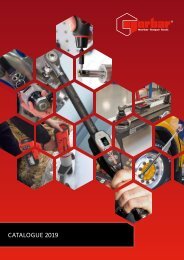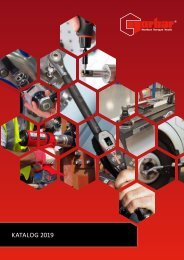Norbar Catalogue 2019
Create successful ePaper yourself
Turn your PDF publications into a flip-book with our unique Google optimized e-Paper software.
CALIBRATION BEAMS & WEIGHTS<br />
CALIBRATION CERTIFICATES<br />
As a UKAS accredited calibration Laboratory No. 0256, <strong>Norbar</strong> is required to calibrate torque measuring devices that are within the laboratory’s scope, in<br />
accordance with BS 7882:2017. See the ‘UKAS Schedule of Accreditation’ on the ‘Calibration Services’ page of our website, www.norbar.com.<br />
<strong>Norbar</strong> can provide a comprehensive range of calibrations including increasing and decreasing torques; clockwise and counter-clockwise; in either SI or<br />
English torque units, or in mV/V or Volts.<br />
The sections below summarise the main features of BS 7882:2017, but purchase and careful study of the standard is advised for those who wish to have<br />
more detailed information.<br />
Procedure<br />
• The 'device' is defined as all parts of a system, e.g. Display, Transducer cable and Transducer. Transducer cables will therefore be serial numbered if they<br />
are separate items.<br />
• The output of the device is defined as 'deflection'.<br />
• It is preferable to calibrate all parts of a system together. If a transducer is sent for calibration without its normal display unit, an equivalent calibrated<br />
display held in the laboratory will be used. The normal display must also be in a calibrated state or the certification for the transducer is invalidated.<br />
• <strong>Norbar</strong> is currently the only laboratory accredited by UKAS for the calibration of Electrical Torque Measuring Indicators.<br />
• Before any calibration or recalibration the torque measuring device is preloaded three times in succession to the maximum applied torque of the device.<br />
Each preload is maintained for a minimum of 30 seconds to exercise the device and stabilise it in the calibration fixture.<br />
• The device is calibrated with at least five approximately equal steps from 20% to 100% of maximum torque. Lower values are allowed as long as they<br />
meet certain criteria for resolution.<br />
• For Classes 0.05 and 0.1, it is mandatory to calibrate the torque measuring device in four different mounting positions each rotated 90° about the<br />
measurement axis. For all other classes the device is calibrated at a minimum of two different mounting positions at least 90° apart.<br />
• Two series of readings are taken, and the device is then disturbed, generally by being disconnected from the calibration fixture and rotated through 90°.<br />
The device is then preloaded once to full scale. A third series of readings are then taken. This process is repeated until readings have been recorded in all<br />
required orientations.<br />
• If reversibility is required, a single series of decreasing torques are applied at the end of the last increasing series.<br />
• Should calibration be required in both directions, the series of readings are repeated in the opposite direction.<br />
• The calibration data is then analysed to establish the following parameters.<br />
Repeatability<br />
The variation between the indicated deflection from series 1 and 2, expressed as a percentage of the mean of the two readings.<br />
Reproducibility<br />
The maximum variation between series 1, 2 and 3, or series 1, 2, 3, 4 and 5 expressed as a percentage of the mean indicated deflection calculated from<br />
series 1, 3 or series 1, 3, 4, and 5.<br />
Error of Indication<br />
Where the results are expressed in units of torque, the errors of indication are the variation between each applied torque and the mean indicated<br />
deflection at that torque.<br />
Error of Zero Torque<br />
The maximum zero reading recorded after each loading series is expressed as a percentage of the maximum mean indicated deflection.<br />
Error of Interpolation<br />
Where the results are expressed in volts or units other than torque units, a second order polynomial equation (best fit line) is established and the<br />
difference in deflection from the computed value is expressed as a percentage of the computed value.<br />
Reversibility<br />
The variation between the readings from the last torque series applied in an increasing mode and the readings for the same given torque applied in a<br />
decreasing mode. Reversibility is expressed as a percentage of the deflection of the last increasing series for the given torque.<br />
Classification<br />
• The parameters are each compared with a table to establish the device’s classification. Class 0.05 is the highest performance, and class 5 is the lowest<br />
defined by the standard. The overall class reported will be that of the lowest performing parameter. For example reproducibility may be a class 1 when<br />
all other parameters meet class 0.5. The device will be classified as 1.<br />
• Additionally the uncertainty of measurement of the applied torque must be five times better than the overall class reported. <strong>Norbar</strong>’s uncertainty of<br />
measurement (typically 0.02%) allows classification to Class 0.1 devices.<br />
• Different classes may be quoted for ranges below 20% of maximum capacity.<br />
Relative Measurement Uncertainty Interval<br />
The relative measurement uncertainty interval of the device is also calculated by combining the relative mean deviation with the relative expanded<br />
uncertainty.<br />
Effectively the uncertainty interval encompasses all of a transducers reported errors and uncertainty of calibration, providing the user with a maximum<br />
error value of the calibrated device.<br />
Accredited calibrations performed to BS 7882:2017 meet the requirements of BS EN ISO6789-2:2017 clause 4.3 and annex C 7.3, and<br />
BS EN ISO 6789-1:2017 clause 6.1.<br />
enquiry@norbar.com | www.norbar.com 122







